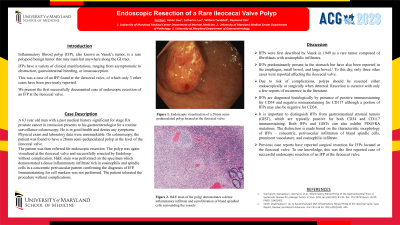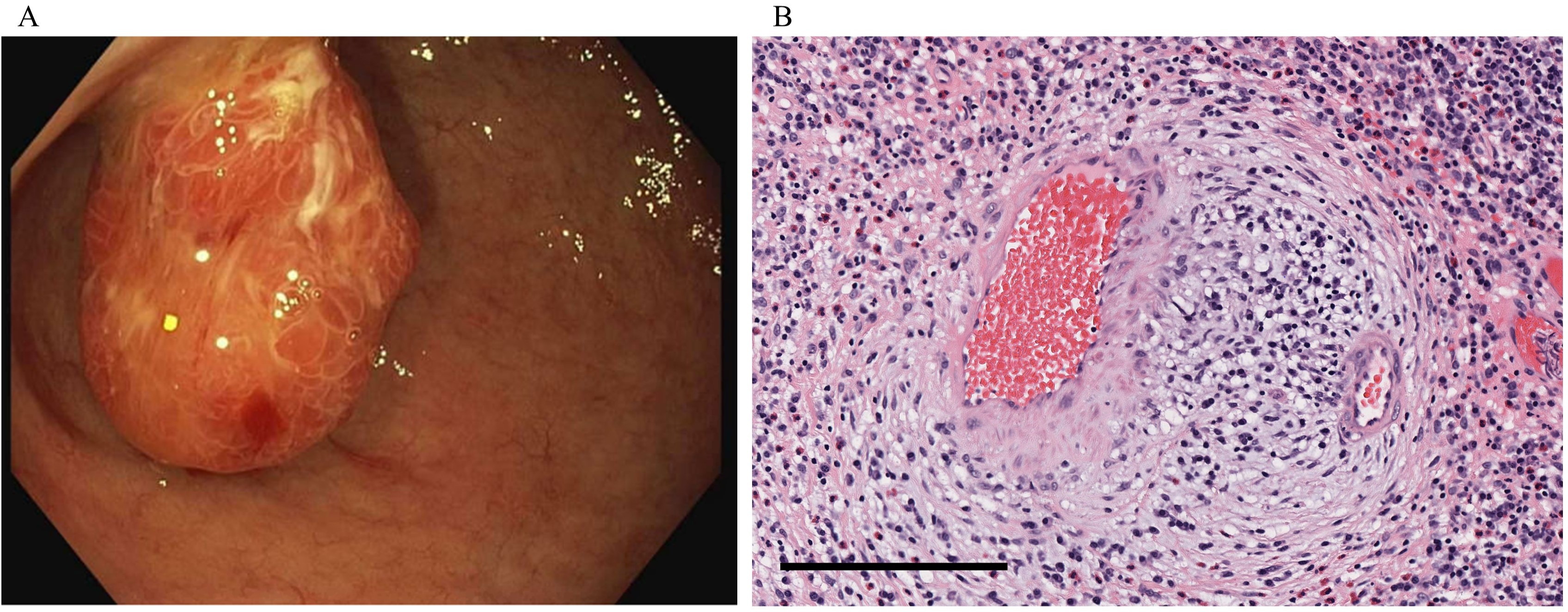Tuesday Poster Session
Category: General Endoscopy
P3419 - Endoscopic Resection of a Rare Ileocecal Valve Polyp
Tuesday, October 24, 2023
10:30 AM - 4:00 PM PT
Location: Exhibit Hall

Has Audio
- PX
Pei Xue, MD
University of Maryland Medical Center
Baltimore, MD
Presenting Author(s)
Award: Presidential Poster Award
Pei Xue, MD1, Kelvin Liao, MD2, Catherine Lee, MD1, William Twaddell, MD1, Raymond Kim, MD, DM1
1University of Maryland Medical Center, Baltimore, MD; 2University of Maryland School of Medicine, Baltimore, MD
Introduction: Inflammatory fibroid polyp (IFP), also known as Vanek’s tumor, is a rare polypoid benign tumor arising from the submucosa. It may manifest anywhere along the GI tract, however most commonly in the stomach. IFP has a variety of clinical manifestations, ranging from asymptomatic to obstructive symptoms and GI bleeding. We present a case of IFP found at the ileocecal valve, of which only 3 other cases have been previously reported.1 To our knowledge, this was the first reported case of successful endoscopic resection of an ileocecal IFP.
Case Description/Methods: A 63 year old man with a past medical history significant for stage IIA prostate cancer in remission presents to his gastroenterologist for a routine surveillance colonoscopy. He is in good health and denies any symptoms. Physical exam and laboratory data were unremarkable. On colonoscopy, the patient was found to have a 28mm semi-pedunculated polyp at the level of the ileocecal valve.
The patient was then referred to our services for endoscopic resection. Again, the polyp was visualized at the ileocecal valve and successfully resected by Endoloop without complication. Pathologic review confirmed the diagnosis of IFP.
Discussion: IFPs were first described by Vanek in 1949 as a rare tumor composed of fibroblasts with eosinophilic infiltrates. These tumors can present as abdominal pain, bloating, gastrointestinal bleeding, or intussusception but may also be asymptomatic as in this case. As a result, the true prevalence of IFPs is unknown. Endoscopic resection is often the treatment of choice due to potential complications from the polyp. However, surgical resection may be required when there is concern for bowel ischemia. Resection is curative with few reports of recurrence in the literature.
Histologically, IFPs are typically characterized by positive immunostaining for CD34 and negative immunostaining for CD117 although a portion of IFPs may also be negative for CD34. This contrasts with gastrointestinal stromal tumors (GIST), which are typically positive for CD34 and CD117 immunostaining. Furthermore, both IFPs and GISTs can exhibit PDGFRA mutations. Nevertheless it is crucial to distinguish these two tumors due to the latter’s metastatic potential.
References:
1. Garmpis N, Damaskos C, Garmpi A, et al. Inflammatory Fibroid Polyp of the Gastrointestinal Tract: A Systematic Review for a Benign Tumor. In Vivo. 2021 Jan-Feb;35(1):81-93.

Disclosures:
Pei Xue, MD1, Kelvin Liao, MD2, Catherine Lee, MD1, William Twaddell, MD1, Raymond Kim, MD, DM1. P3419 - Endoscopic Resection of a Rare Ileocecal Valve Polyp, ACG 2023 Annual Scientific Meeting Abstracts. Vancouver, BC, Canada: American College of Gastroenterology.
Pei Xue, MD1, Kelvin Liao, MD2, Catherine Lee, MD1, William Twaddell, MD1, Raymond Kim, MD, DM1
1University of Maryland Medical Center, Baltimore, MD; 2University of Maryland School of Medicine, Baltimore, MD
Introduction: Inflammatory fibroid polyp (IFP), also known as Vanek’s tumor, is a rare polypoid benign tumor arising from the submucosa. It may manifest anywhere along the GI tract, however most commonly in the stomach. IFP has a variety of clinical manifestations, ranging from asymptomatic to obstructive symptoms and GI bleeding. We present a case of IFP found at the ileocecal valve, of which only 3 other cases have been previously reported.1 To our knowledge, this was the first reported case of successful endoscopic resection of an ileocecal IFP.
Case Description/Methods: A 63 year old man with a past medical history significant for stage IIA prostate cancer in remission presents to his gastroenterologist for a routine surveillance colonoscopy. He is in good health and denies any symptoms. Physical exam and laboratory data were unremarkable. On colonoscopy, the patient was found to have a 28mm semi-pedunculated polyp at the level of the ileocecal valve.
The patient was then referred to our services for endoscopic resection. Again, the polyp was visualized at the ileocecal valve and successfully resected by Endoloop without complication. Pathologic review confirmed the diagnosis of IFP.
Discussion: IFPs were first described by Vanek in 1949 as a rare tumor composed of fibroblasts with eosinophilic infiltrates. These tumors can present as abdominal pain, bloating, gastrointestinal bleeding, or intussusception but may also be asymptomatic as in this case. As a result, the true prevalence of IFPs is unknown. Endoscopic resection is often the treatment of choice due to potential complications from the polyp. However, surgical resection may be required when there is concern for bowel ischemia. Resection is curative with few reports of recurrence in the literature.
Histologically, IFPs are typically characterized by positive immunostaining for CD34 and negative immunostaining for CD117 although a portion of IFPs may also be negative for CD34. This contrasts with gastrointestinal stromal tumors (GIST), which are typically positive for CD34 and CD117 immunostaining. Furthermore, both IFPs and GISTs can exhibit PDGFRA mutations. Nevertheless it is crucial to distinguish these two tumors due to the latter’s metastatic potential.
References:
1. Garmpis N, Damaskos C, Garmpi A, et al. Inflammatory Fibroid Polyp of the Gastrointestinal Tract: A Systematic Review for a Benign Tumor. In Vivo. 2021 Jan-Feb;35(1):81-93.

Figure: (A) Endoscopic image of ileocecal valve polyp. (B) High-power view showing spindled cells in a concentric perivascular pattern with inflammatory infiltrate rich in eosinophils. Bar = 200 μm.
Disclosures:
Pei Xue indicated no relevant financial relationships.
Kelvin Liao indicated no relevant financial relationships.
Catherine Lee indicated no relevant financial relationships.
William Twaddell indicated no relevant financial relationships.
Raymond Kim: Apollo Endosurgery – Consultant. Cook medical – Consultant.
Pei Xue, MD1, Kelvin Liao, MD2, Catherine Lee, MD1, William Twaddell, MD1, Raymond Kim, MD, DM1. P3419 - Endoscopic Resection of a Rare Ileocecal Valve Polyp, ACG 2023 Annual Scientific Meeting Abstracts. Vancouver, BC, Canada: American College of Gastroenterology.

